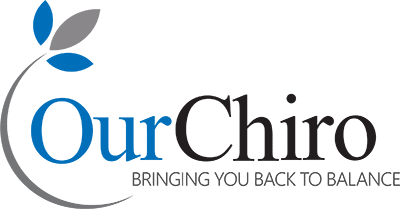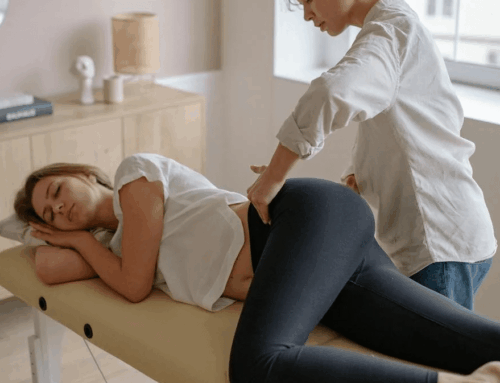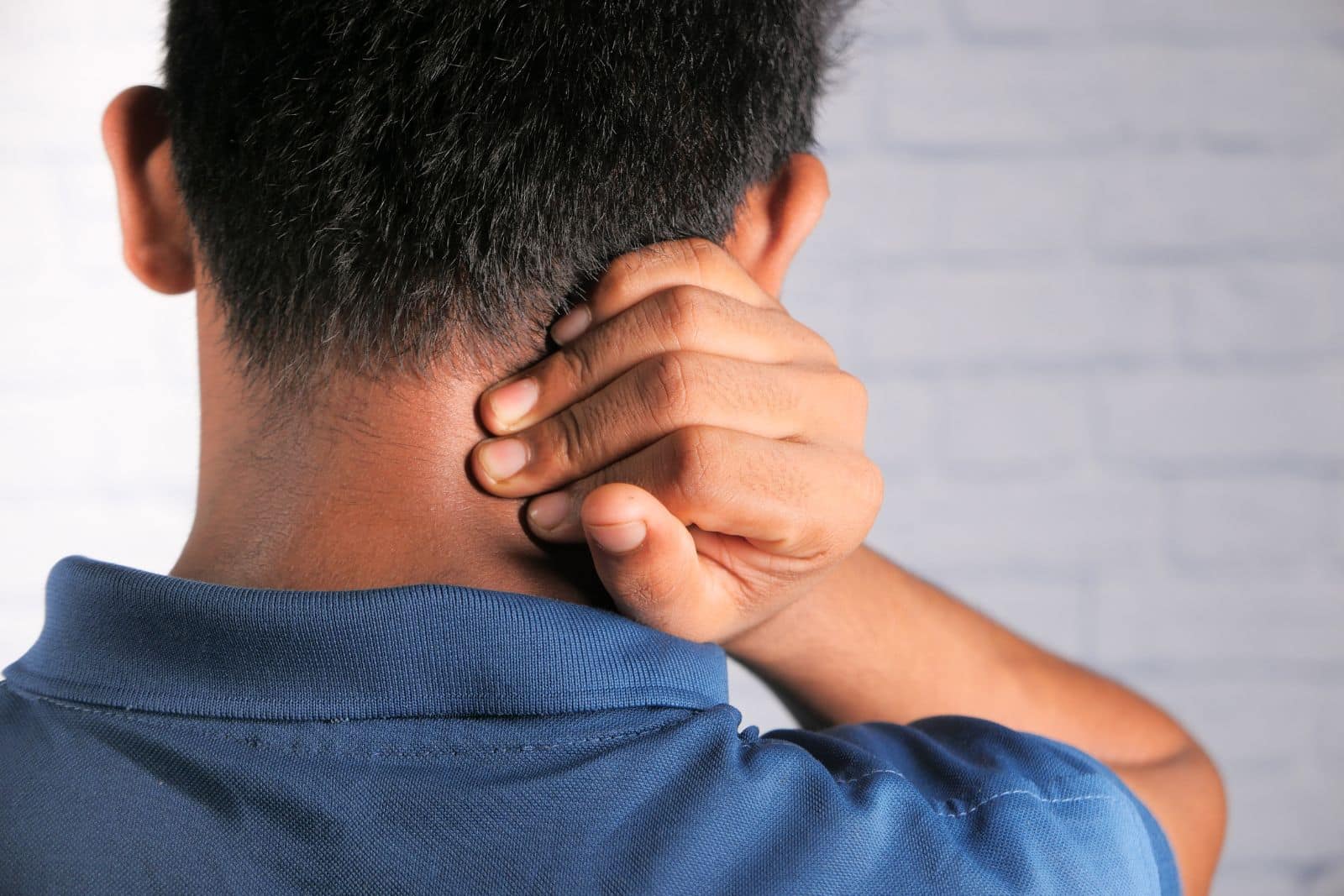
As a common problem, shoulder pain can cause a great deal of discomfort and disruption to daily life. It affects people from all walks of life, from active athletes to those with a more sedentary lifestyle. But sometimes, what feels like a shoulder problem is actually a problem originating in the neck.
This fact sheet is designed to provide you with a comprehensive overview of the intricate relationship between shoulder and neck pain, and how chiropractic care may offer a path to recovery.
In this article, Dr. Simon Nash (Chiropractor) discusses how your neck can be the root cause of your shoulder pain and the different approaches a chiropractor might take to help with the symptoms.
Please note: The information provided in this article is for general knowledge and informational purposes only, and does not constitute medical advice. It is essential to consult with a qualified healthcare professional for a diagnosis and personalised treatment plan.
Table of Contents
- Understanding the Neck-Shoulder Connection
- Diagnosing the Source of Your Pain
- The Chiropractic Approach to Neck and Shoulder Pain
- Frequently Asked Questions (FAQs)
- Book a Consult with Our Chiro Brisbane
- References
- Video Transcript
Understanding the Neck-Shoulder Connection
The proximity of the neck (cervical spine) and shoulder joint means that a problem in one area can easily mimic pain in the other. This is because the nerves that supply the shoulder and arm originate in the neck.
“Sometimes we’ll see patients come in with a shoulder pain or a pain that runs down their arm that’s actually coming from the cervical spine origin, so your neck,” explains Dr. Nash.
This phenomenon, known as referred pain, is a key reason why an accurate diagnosis is crucial. A problem in the cervical spine, such as a compressed nerve, can project pain, tingling, or numbness to the shoulder, arm, and even the hand. The main culprit for this referred pain is the brachial plexus, a network of nerves that run from the neck, under the collarbone, and into the arm.
“Out of your cervical spine, you actually have a thing called the brachial plexus, which runs three big nerves out of the neck and then down the arm. And that commonly can refer to pain to the tip of the shoulder, down to the elbow, or even down to the hand.”
Another common source of referred pain from the neck are the facet joints, which are small, stabilising joints at the back of the spine. When these joints become irritated or inflamed, they can also refer pain down the arm.
Dr. Nash notes, “If you have an irritated facet joint, that can also refer to pain down into the shoulder or down into the arm.”
A classic example of this is a “stinger” injury, often seen in contact sports like rugby. A blow to the shoulder or neck can stretch the brachial plexus, causing a sharp, electric-like pain and temporary weakness or numbness in the arm. The player may feel the pain in their shoulder, when the underlying issue is nerve irritation in the neck.
Diagnosing the Source of Your Pain
When a patient presents with shoulder pain, a chiropractor’s first and most important task is to determine the true source of the problem. This is where a thorough physical examination and orthopaedic testing come into play.
“When we see a patient with shoulder pain, we want to make sure that it’s not coming from the neck,” says Dr. Nash.
This process involves a series of specific movements and tests to assess the range of motion and function of both the neck and the shoulder. This helps differentiate between a localised shoulder injury (like a rotator cuff tear) and pain that is originating from a cervical spine issue.
“Typically in that scenario, we would do some orthopaedic testing around the cervical spine to make sure that the pain that they’re feeling in their shoulder is not coming from their neck.”
If the chiropractor’s initial assessment suggests a more complex issue, they may recommend further imaging, such as an X-ray or MRI, to get a clearer picture of the underlying structures and rule out more serious conditions.
The Chiropractic Approach to Neck and Shoulder Pain
Once the source of the pain is identified, the treatment plan can be tailored specifically to the patient’s needs. Chiropractic care for neck and shoulder pain is not a one-size-fits-all approach. The treatment methods used will depend entirely on whether the pain is a true shoulder problem or referred pain from the neck.
Treating True Shoulder Pain
If the pain is confirmed to be coming from the shoulder joint itself, a chiropractor may use a combination of techniques to restore function and reduce inflammation.
“Once we’ve established that it is coming from the shoulder, we can then use a range of different treatment modalities such as needling, soft tissue work, some mobilisations, Kinesio taping, and some manual adjusting around that area to help with that shoulder pain,” says Dr. Nash.
These treatments are aimed at improving joint mobility, releasing muscle tension, and promoting blood flow to the area, which aids in the healing process.
Treating Neck-Related Shoulder Pain
When the shoulder pain is found to be a symptom of a neck problem, the focus of treatment shifts to the cervical spine. A chiropractor will work to address the underlying irritation or compression of the nerves.
Dr. Nash notes, “If it is coming from the cervical spine, we will do a different technique where we will do some manual adjusting or activator adjusting around the cervical spine again to restore the biomechanics of the joints.”
This may also involve soft tissue work on the muscles surrounding the neck and upper back, which can often be tight and contribute to nerve irritation. A randomised controlled trial by Jull et al. (2002) found that manipulative therapy, when combined with specific exercises, was effective in reducing the frequency and intensity of cervicogenic headaches (headaches originating from the neck), demonstrating the benefits of targeting the cervical spine for pain relief (Jull et al., 2002).
The Role of Rehabilitation and Education
Regardless of the cause, a crucial component of chiropractic care is patient education and rehabilitation. Your chiropractor will provide you with a personalised plan of exercises and stretches to do at home.
“We will do some Kinesio taping and give the patient some exercises or a bit of a rehab plan to do at home when they’re not in the clinic,” says Dr. Nash.
This active involvement is key to long-term recovery and helps to strengthen the supporting muscles, improve posture, and prevent future recurrences of pain. A study by Bronfort et al. (2012) found that for acute and subacute neck pain, spinal manipulation was more effective than medication in both the short and long term. This evidence suggests that a multimodal approach involving hands-on care and patient empowerment is often more beneficial than simply relying on medication (Bronfort et al., 2012).
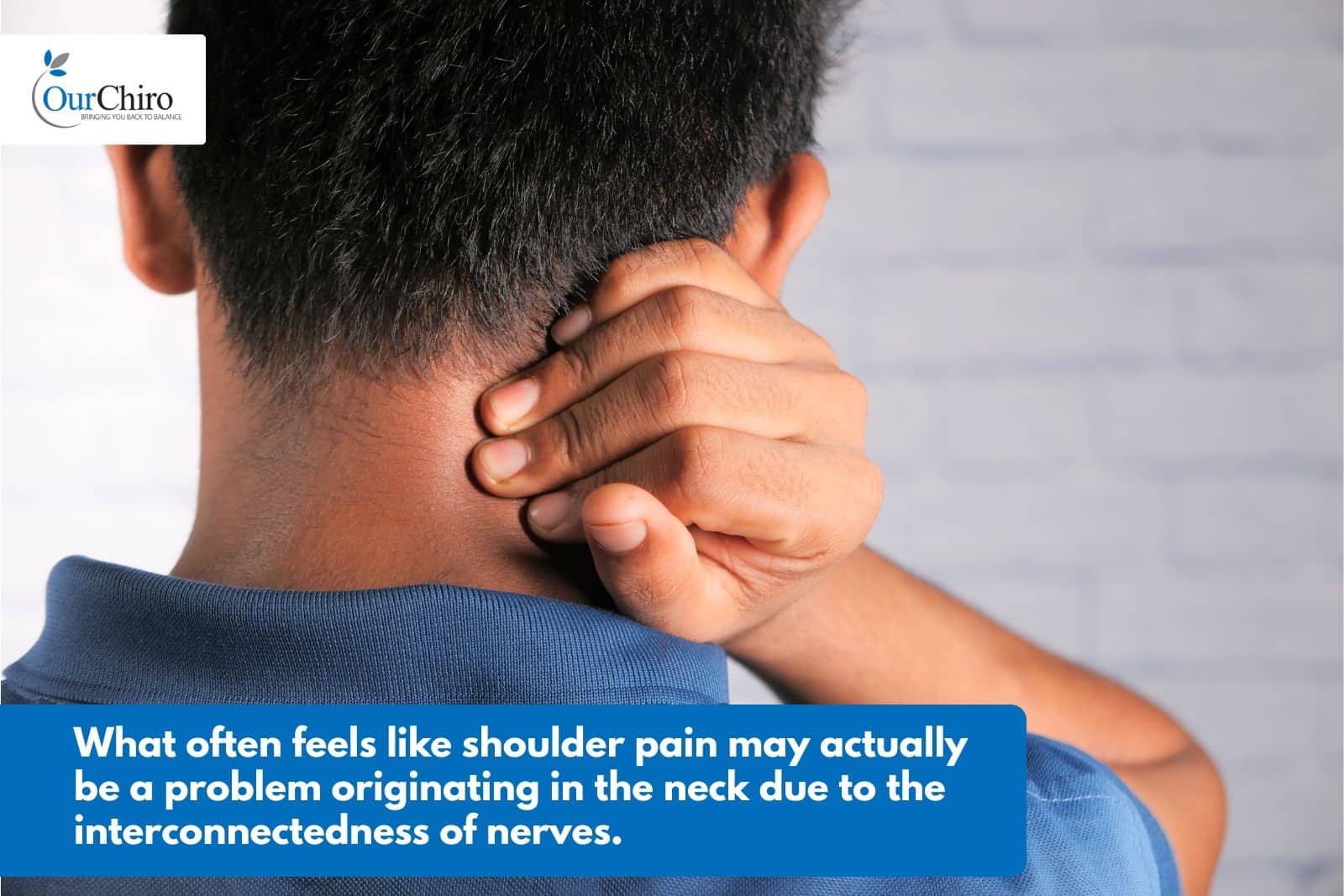
Frequently Asked Questions (FAQs)
Q1: What are the common symptoms of neck-related shoulder pain?
A: Symptoms can include pain that radiates down the arm, tingling or numbness in the shoulder or hand, and muscle weakness. The pain may feel sharp or burning and can be accompanied by neck stiffness.
Q2: Will a chiropractor “crack” my neck to fix my shoulder pain?
A: Not necessarily. Your chiropractor will choose the most appropriate and gentle technique for your condition. This may include manual adjustments but could also involve mobilisations, soft tissue work, or the use of an Activator tool.
Q3: Can poor posture cause neck and shoulder pain?
A: Yes, prolonged poor posture, such as slouching, can place extra stress on the neck and upper back, leading to muscle tension and nerve irritation that can cause referred pain to the shoulder.
Q4: How long will it take to recover from neck-related shoulder pain?
A: The recovery time varies based on the underlying cause and severity of the condition. Your chiropractor will provide a personalised treatment plan and a realistic timeline for recovery during your initial consultation.
Q5: Is it safe to exercise with this kind of pain?
A: It is essential to consult with your chiropractor or healthcare professional before exercising. While certain gentle stretches and exercises can be beneficial, strenuous or incorrect movements can worsen the condition.
Q6: What is the brachial plexus, and how does it relate to my pain?
A: The brachial plexus is a network of nerves that exits the neck and travels down the arm. If these nerves are compressed or irritated by a neck problem (like a disc issue or tight muscle), they can cause referred pain and other symptoms in the shoulder, arm, and hand.
Book a Consult with Our Chiro Brisbane
We understand how frustrating and confusing it can be when you’re experiencing shoulder pain that just won’t go away. The constant discomfort can make it difficult to enjoy life and participate in the activities you love, and it can feel like you’re trapped in a cycle of pain. At Our Chiro Brisbane, we are dedicated to helping you find relief and get back to doing the things you love.
Our experienced chiropractors will work with you to identify the root cause of your pain, whether it’s a true shoulder problem or an issue stemming from your neck, and develop a personalised treatment plan tailored to your specific needs. Using a combination of gentle, evidence-based care and advanced techniques, we aim to not only relieve your pain but also restore function and prevent future flare-ups.
Take the first step towards a pain-free life. Book a New Patient Exam and Chiropractic Consultation with Our Chiro Brisbane today.
References
- Bronfort, G., Evans, R., Anderson, A. V., Svendsen, K. H., Bracha, R., & Casey, L. S. (2012). Spinal manipulation, medication, or home exercise with advice for acute and subacute neck pain: a randomized trial. Annals of Internal Medicine, 156(1 Pt 1), 20–30. https://doi.org/10.7326/0003-4819-156-1-201201030-00002
- Jull, G. A., Trott, P., Potter, A., Zito, G., Niere, K., Shirley, E., … & Richardson, C. (2002). A randomized controlled trial of exercise and manipulative therapy for cervicogenic headache. Journal of Manipulative and Physiological Therapeutics, 25(8), 534–540. https://pubmed.ncbi.nlm.nih.gov/12221344/
Video transcript
Is your shoulder pain a neck problem? Shoulder and neck pain are closely related because they’re obviously really close to where you are on your body. Sometimes we’ll see patients come in with shoulder pain or a pain that runs down their arm that’s actually coming from the cervical spine origin, so your neck. And that’s because out of your cervical spine, you actually have a thing called the brachial plexus, which runs three runs of three big nerves out of the neck and then down the arm. And that commonly can refer pain to the tip of the shoulder, down to the elbow, or even down to the hand. So sometimes shoulder pain can be actually missed as a neck pain problem. With the neck as well, we have facet joints which make up the joints of the spine and they can also refer to pain down the arm. So if you have an irritated facet joint, that can also refer pain down into the shoulder or down into the arm. When we see a patient with shoulder pain, we want to make sure that it’s not coming from the neck. So, typically in that scenario, we would do some orthopedic testing around the cervical spine and some other testing to make sure that the pain that they’re feeling in their shoulder is not coming from their neck. So, when a patient comes in with shoulder pain, we want to assess uh and make sure that that is not coming from the cervical spine origin. So, we will do some orthopedic testing to make sure that the cervical spine’s clear. If that’s inconclusive or we think there’s a need to refer out for an X-ray or any other further imaging, we’ll do that. Once we’ve established that it is coming from the shoulder, we can then use a range of different treatment modalities such as needling soft tissue work, some mobilisations, kinesio taping and some manual adjusting around that area to help with that shoulder pain. And if it is coming from the cervical spine, we will do a different technique where we will do some manual adjusting or activator adjusting around the cervical spine again to restore the biomechanics of the joints. If it’s coming from anywhere else, such as muscle muscle pain, we might do some dry needling in and around the cervical spine or up in the upper traps and also we will do some kinesis taping and give the patient some exercises or rehab. A bit of a rehab plan to do at home when they’re not in the clinic. So the reason it’s actually important to make sure that it’s not coming from the neck and that it is actually shoulder pain. An example we would see is, for example a rugby or rugby league player in where they’re tackling, they might irritate up through the neck and that will pull on the brachial plexus which are the nerves that exit from the neck and that patient would have what they call a stinger is where their arm gets really sore, it’s potentially numb. So they might come in then on the Monday after the game and they be like, “Oh, my shoulder is really, really sore.” So we want to make sure that it’s actually coming from the shoulder and it’s not coming from the neck or any of the tissues surrounding the neck that could cause that pain, such as the discs, such as the facet joints or any of the other neural tissue around that area.
